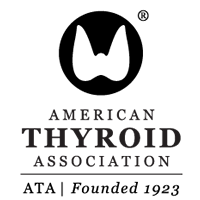
October 17, 2018—The American Thyroid Association (ATA) announces with pleasure that Elizabeth Pearce, MD, MSc, began a one-year term as president of the Board of Directors at the close of the Annual Meeting, October 7 in Washington, DC. Dr. Pearce has served for the past year as President-Elect.
Newly elected board members are:
Martha Zeiger, MD, President-Elect
Jacqueline Jonklaas, MD, Secretary-Elect
Joshua Klopper, MD, Director
Angela Leung, MD, MSc, Director
Elizabeth Pearce, MD, MSc, Board President
 Dr. Pearce is professor of medicine in the Endocrinology, Diabetes, and Nutrition Section at Boston University School of Medicine. She received her undergraduate and medical degrees from Harvard and a masters' degree in epidemiology from the Boston University School of Public Health. She completed her residency in internal medicine at Beth Israel Deaconess Medical Center, and her fellowship in endocrinology at Boston University under the mentorship of Dr. Lewis Braverman. Her research interests include: the sufficiency of dietary iodine in the U.S. and globally; thyroid function in pregnancy; thyroidal effects of exposure to environmental endocrine disruptors; and the cardiovascular effects of subclinical thyroid dysfunction. She has been part of the leadership of the Iodine Global Network (IGN; formerly ICCIDD) since 2009. She is a member of the AACE Thyroid Disease State Network and serves as faculty for the Endocrine Society's annual board review course. She has served on multiple editorial boards, including those for Endocrine Practice, Journal of Clinical Endocrinology and Metabolism, Clinical Endocrinology, European Journal of Clinical Nutrition, and Lancet Diabetes & Endocrinology.
Dr. Pearce is professor of medicine in the Endocrinology, Diabetes, and Nutrition Section at Boston University School of Medicine. She received her undergraduate and medical degrees from Harvard and a masters' degree in epidemiology from the Boston University School of Public Health. She completed her residency in internal medicine at Beth Israel Deaconess Medical Center, and her fellowship in endocrinology at Boston University under the mentorship of Dr. Lewis Braverman. Her research interests include: the sufficiency of dietary iodine in the U.S. and globally; thyroid function in pregnancy; thyroidal effects of exposure to environmental endocrine disruptors; and the cardiovascular effects of subclinical thyroid dysfunction. She has been part of the leadership of the Iodine Global Network (IGN; formerly ICCIDD) since 2009. She is a member of the AACE Thyroid Disease State Network and serves as faculty for the Endocrine Society's annual board review course. She has served on multiple editorial boards, including those for Endocrine Practice, Journal of Clinical Endocrinology and Metabolism, Clinical Endocrinology, European Journal of Clinical Nutrition, and Lancet Diabetes & Endocrinology.
Dr. Pearce has been a member of the American Thyroid Association since 2000. She has chaired both the ATA's Publications and Public Health Committees. She cochaired the 2012 Annual Meeting Program Committee and the 2009 and 2016 Spring Symposia and was a member of the Program Committee for the 2015 International Thyroid Congress. Dr. Pearce has also served as a member of the ATA Finance Committee and the Guidelines Policy Task Force. She was one of the leaders in establishing the ATA's Braverman Lectureship and cochaired the task force for the 2017 Pregnancy Guidelines. She is associate editor for both Thyroid and Clinical Thyroidology journals. She served as a member of the Board of Directors from 2009 to 2013 and again as president-elect for the past year. Dr. Pearce was the 2011 recipient of the Van Meter Award for outstanding contributions to research on the thyroid gland.
Martha Zeiger, MD, President-Elect
 Dr. Martha Zeiger is the S. Hurt Watts professor and chair of surgery at the University of Virginia School of Medicine. Regarded as a world leader in endocrine surgery, she is also an expert in the molecular aspects of thyroid cancer and an experienced academic leader. Her surgical training includes a surgical oncology fellowship, focused on endocrine surgery, at the National Cancer Institute, NIH, prior to joining the faculty at Johns Hopkins University School of Medicine in 1993. There, she built her endocrine surgery practice, established an endocrine surgery fellowship program, and directed an NIH-funded molecular biology laboratory for over 20 years. Today, her research team continues at Johns Hopkins, focusing on the molecular aspects of thyroid cancer.
Dr. Martha Zeiger is the S. Hurt Watts professor and chair of surgery at the University of Virginia School of Medicine. Regarded as a world leader in endocrine surgery, she is also an expert in the molecular aspects of thyroid cancer and an experienced academic leader. Her surgical training includes a surgical oncology fellowship, focused on endocrine surgery, at the National Cancer Institute, NIH, prior to joining the faculty at Johns Hopkins University School of Medicine in 1993. There, she built her endocrine surgery practice, established an endocrine surgery fellowship program, and directed an NIH-funded molecular biology laboratory for over 20 years. Today, her research team continues at Johns Hopkins, focusing on the molecular aspects of thyroid cancer.
While at John Hopkins, Dr. Zeiger took the lead as: associate dean for postdoctoral affairs; professor of surgery, oncology, cellular and molecular medicine; associate vice chair of surgery faculty development; and medical director of business development, strategic alliance, and venture technology. While associate dean for postdoctoral affairs, she oversaw 1,200 research fellows in the School of Medicine. She also established a formal program for international postdoctoral fellows.
Dr. Zeiger has held numerous leadership positions in national medical societies: the American Association of Endocrine Surgeons, the American Association of Clinical Endocrinologists, and the ATA. Through AAES, she founded Endocrine Surgery University, an annual course for all endocrine surgery fellows in North America.
She has served on the ATA Board of Directors and many ATA committees, including publications, membership, conflict of interest task force. She co-chaired the annual meeting program committee in 2011.
Jacqueline Jonklaas, MD, Secretary-Elect
 Dr. Jonklaas is currently a professor in the endocrinology division at Georgetown University in Washington, DC, where she completed her medical degree, residency, and fellowship training. As a clinical researcher in the thyroid field, her time is divided between research, clinical activities, and teaching. Dr. Jonklaas's research has focused on the management of hypothyroidism and thyroid cancer. Current research involves examining patient-reported outcomes after radioiodine therapy. Her recent publications address topics such as how to optimize the treatment of hypothyroidism and the outcomes of thyroid cancer patients based on their treatment, age, and gender.
Dr. Jonklaas is currently a professor in the endocrinology division at Georgetown University in Washington, DC, where she completed her medical degree, residency, and fellowship training. As a clinical researcher in the thyroid field, her time is divided between research, clinical activities, and teaching. Dr. Jonklaas's research has focused on the management of hypothyroidism and thyroid cancer. Current research involves examining patient-reported outcomes after radioiodine therapy. Her recent publications address topics such as how to optimize the treatment of hypothyroidism and the outcomes of thyroid cancer patients based on their treatment, age, and gender.
She is the program director of the Georgetown University Clinical Research Unit. She is involved in translational research and the activities of the Georgetown University's Clinical and Translational Science Award. She recently directed the endocrinology courses for Georgetown University Medical School's first- and second-year medical students. She currently teaches in these courses.
She serves on the editorial board of the Journal of Clinical Endocrinology and Metabolism. She is involved in teaching at the national level as a member of the Endocrine Society Self-Assessment Committee.
Dr. Jonklaas has been a member of the ATA since 1999. She has served on several past ATA committees, including the Patient Education and Advocacy Committee, the Surgical Task Force Committee, and the Awards Committee. She was cochair of the ATA Task Force on Thyroid Hormone Replacement, whose guidelines were published in 2014. She previously served on the Board of Directors from 2013–2017, and recently completed a term as the cochair of the Guidelines and Statement Committee. Currently she serves on the Program Committee. She also serves on the editorial board of the ATA journal Thyroid.
Joshua Klopper, MD, Director (Endocrinologist in Community Practice)
D r. Klopper joined the Colorado Permanente Medical Group (CPMG) of Kaiser Permanente in July 2015 and was appointed chief of the department in April 2016. He was appointed associate clinical professor of medicine in the Division of Endocrinology, Metabolism, and Diabetes at the University of Colorado School of Medicine in October 2015.
r. Klopper joined the Colorado Permanente Medical Group (CPMG) of Kaiser Permanente in July 2015 and was appointed chief of the department in April 2016. He was appointed associate clinical professor of medicine in the Division of Endocrinology, Metabolism, and Diabetes at the University of Colorado School of Medicine in October 2015.
He earned a B.S. in psychology in 1995 from Indiana University in Bloomington, Indiana. In 1999 he received his medical degree from the Emory University School of Medicine in Atlanta, Georgia. He completed his internship and residency in internal medicine at the University of Colorado Health Sciences Center in 2002. Dr. Klopper then completed a postdoctoral research fellowship in the Endocrinology Division, prior to starting his endocrinology fellowship at the University of Colorado at Denver Health Sciences Center, completed in 2006.
Dr. Klopper was a full-time faculty member in the Division of Endocrinology at the University of Colorado School of Medicine from 2006–2015, where he specialized in the evaluation and management of thyroid nodules and thyroid cancer, including advanced thyroid cancer. During his academic career, he received grant funding at the local, state, and national level including from the American Cancer Society. He has published original research on the evaluation and management of thyroid nodules and advanced thyroid cancer and has written several book chapters and reviews. Additionally, he participated as an original member of the Thyroid Cancer Care Collaborative development committee. He has served on the Clinical Affairs and Development committees of the ATA as well as on the Endocrine Society Annual Meeting Steering committee. Currently, Dr. Klopper is on the Medical Specialty Peer Review Committee for CPMG and has been codirector of the Endocrine Society's Introductory Hands-On Thyroid Ultrasound Workshop since 2014.
Angela Leung, MD, MSc, Director (Endocrinologist in Academic Practice)
 Angela M. Leung, MD, MSc, is an assistant professor of medicine in the Division of Endocrinology, Diabetes, and Metabolism at the UCLA David Geffen School of Medicine and in the VA Greater Los Angeles Healthcare System, and an associate program director of the UCLA/VA endocrinology fellowship program.
Angela M. Leung, MD, MSc, is an assistant professor of medicine in the Division of Endocrinology, Diabetes, and Metabolism at the UCLA David Geffen School of Medicine and in the VA Greater Los Angeles Healthcare System, and an associate program director of the UCLA/VA endocrinology fellowship program.
She received her undergraduate degree at Occidental College in Los Angeles, her medical degree from the Boston University School of Medicine, and a masters' degree in epidemiology from the Boston University School of Public Health. She completed her internal medicine residency and a clinical and research endocrine fellowship at Boston University Medical Center. Her research areas of interest include iodine deficiency and excess, thyroid toxicant exposures, and maternal-child thyroid health. She is a member of the AACE Thyroid Disease State Network and the editorial board of Endocrine Practice, has participated in the AACE Endocrine Training Support Committee, and was a recipient of the Endocrine Society Early Investigator Award. She has reviewed for several NIH standing and early-career award endocrine study sections; for the U.S. EPA's Biologically-Based Dose Response model to guide perchlorate regulation in U.S. drinking water; and for the EPA's draft toxicity assessments of the thyroid disruptors GenX and perfluorobutane sulfonate. Through the Endocrine Society, she participates in reviewing the effects of thyroid toxicants for the Organization for Economic Cooperation and Development, a global initiative focused on the regulatory policies of endocrine disruptors.
Dr. Leung has been involved in multiple ATA programs and initiatives. She serves on the editorial boards of three ATA journals: Thyroid, Clinical Thyroidology, and Clinical Thyroidology for the Public. She is past Chair of the ATA Public Health Committee (2012–16), during which she led the publication of the ATA's statements on iodine excess and the use of potassium iodide in nuclear accidents; was a member of the Program Committee for the 2016 ATA Annual Meeting; and served as clinical cochair for the 2017 ATA Annual Meeting in Victoria, British Columbia.
The ATA thanks this year's Nominating Committee, chaired by David Steward, and the Secretary-Elect Selection Task Force, chaired by John Morris. We are extremely grateful to all who serve on the Board of Directors. Special thanks go to those who will retire from the Board this year: Regina Castro, MD, Christine Spitzweg, MD, and outgoing Past-President John C. Morris, MD.
###
The American Thyroid Association (ATA) is the leading worldwide organization dedicated to the advancement, understanding, prevention, diagnosis, and treatment of thyroid disorders and thyroid cancer. ATA is an international membership medical society with over 1,700 members from 43 countries around the world. Celebrating its 95th anniversary, the ATA continues to deliver its mission of being devoted to thyroid biology and to the prevention and treatment of thyroid disease through excellence in research, clinical care, education, and public health. These efforts are carried out via several key endeavors:
- The publication of the highly regarded professional journals Thyroid, Clinical Thyroidology, and VideoEndocrinology
- Annual scientific meetings
- Biennial clinical and research symposia
- Research grant programs for young investigators
- Support of online professional, public, and patient educational programs
- Development of guidelines for clinical management of thyroid disease and thyroid cancer
The ATA promotes thyroid awareness and information online through Clinical Thyroidology for the Public and extensive, authoritative explanations of thyroid disease and thyroid cancer in both English and Spanish. The ATA website serves as the clinical resource for patients and the public who look for reliable information on the Internet. Every fifth year, the American Thyroid Association joins with the Latin American Thyroid Society, the European Thyroid Association, and the Asia and Oceania Thyroid Association to cosponsor the International Thyroid Congress (ITC).
The post American Thyroid Association: Dr. Elizabeth Pearce to Lead 2018-2019 Board of Directors appeared first on American Thyroid Association.
https://ift.tt/2zsSx4l


 Dr. Pearce is professor of medicine in the Endocrinology, Diabetes, and Nutrition Section at Boston University School of Medicine. She received her undergraduate and medical degrees from Harvard and a masters' degree in epidemiology from the Boston University School of Public Health. She completed her residency in internal medicine at Beth Israel Deaconess Medical Center, and her fellowship in endocrinology at Boston University under the mentorship of Dr. Lewis Braverman. Her research interests include: the sufficiency of dietary iodine in the U.S. and globally; thyroid function in pregnancy; thyroidal effects of exposure to environmental endocrine disruptors; and the cardiovascular effects of subclinical thyroid dysfunction. She has been part of the leadership of the Iodine Global Network (IGN; formerly ICCIDD) since 2009. She is a member of the AACE Thyroid Disease State Network and serves as faculty for the Endocrine Society's annual board review course. She has served on multiple editorial boards, including those for Endocrine Practice, Journal of Clinical Endocrinology and Metabolism, Clinical Endocrinology, European Journal of Clinical Nutrition, and Lancet Diabetes & Endocrinology.
Dr. Pearce is professor of medicine in the Endocrinology, Diabetes, and Nutrition Section at Boston University School of Medicine. She received her undergraduate and medical degrees from Harvard and a masters' degree in epidemiology from the Boston University School of Public Health. She completed her residency in internal medicine at Beth Israel Deaconess Medical Center, and her fellowship in endocrinology at Boston University under the mentorship of Dr. Lewis Braverman. Her research interests include: the sufficiency of dietary iodine in the U.S. and globally; thyroid function in pregnancy; thyroidal effects of exposure to environmental endocrine disruptors; and the cardiovascular effects of subclinical thyroid dysfunction. She has been part of the leadership of the Iodine Global Network (IGN; formerly ICCIDD) since 2009. She is a member of the AACE Thyroid Disease State Network and serves as faculty for the Endocrine Society's annual board review course. She has served on multiple editorial boards, including those for Endocrine Practice, Journal of Clinical Endocrinology and Metabolism, Clinical Endocrinology, European Journal of Clinical Nutrition, and Lancet Diabetes & Endocrinology. Dr. Martha Zeiger is the S. Hurt Watts professor and chair of surgery at the University of Virginia School of Medicine. Regarded as a world leader in endocrine surgery, she is also an expert in the molecular aspects of thyroid cancer and an experienced academic leader. Her surgical training includes a surgical oncology fellowship, focused on endocrine surgery, at the National Cancer Institute, NIH, prior to joining the faculty at Johns Hopkins University School of Medicine in 1993. There, she built her endocrine surgery practice, established an endocrine surgery fellowship program, and directed an NIH-funded molecular biology laboratory for over 20 years. Today, her research team continues at Johns Hopkins, focusing on the molecular aspects of thyroid cancer.
Dr. Martha Zeiger is the S. Hurt Watts professor and chair of surgery at the University of Virginia School of Medicine. Regarded as a world leader in endocrine surgery, she is also an expert in the molecular aspects of thyroid cancer and an experienced academic leader. Her surgical training includes a surgical oncology fellowship, focused on endocrine surgery, at the National Cancer Institute, NIH, prior to joining the faculty at Johns Hopkins University School of Medicine in 1993. There, she built her endocrine surgery practice, established an endocrine surgery fellowship program, and directed an NIH-funded molecular biology laboratory for over 20 years. Today, her research team continues at Johns Hopkins, focusing on the molecular aspects of thyroid cancer. Dr. Jonklaas is currently a professor in the endocrinology division at Georgetown University in Washington, DC, where she completed her medical degree, residency, and fellowship training. As a clinical researcher in the thyroid field, her time is divided between research, clinical activities, and teaching. Dr. Jonklaas's research has focused on the management of hypothyroidism and thyroid cancer. Current research involves examining patient-reported outcomes after radioiodine therapy. Her recent publications address topics such as how to optimize the treatment of hypothyroidism and the outcomes of thyroid cancer patients based on their treatment, age, and gender.
Dr. Jonklaas is currently a professor in the endocrinology division at Georgetown University in Washington, DC, where she completed her medical degree, residency, and fellowship training. As a clinical researcher in the thyroid field, her time is divided between research, clinical activities, and teaching. Dr. Jonklaas's research has focused on the management of hypothyroidism and thyroid cancer. Current research involves examining patient-reported outcomes after radioiodine therapy. Her recent publications address topics such as how to optimize the treatment of hypothyroidism and the outcomes of thyroid cancer patients based on their treatment, age, and gender. r. Klopper joined the Colorado Permanente Medical Group (CPMG) of Kaiser Permanente in July 2015 and was appointed chief of the department in April 2016. He was appointed associate clinical professor of medicine in the Division of Endocrinology, Metabolism, and Diabetes at the University of Colorado School of Medicine in October 2015.
r. Klopper joined the Colorado Permanente Medical Group (CPMG) of Kaiser Permanente in July 2015 and was appointed chief of the department in April 2016. He was appointed associate clinical professor of medicine in the Division of Endocrinology, Metabolism, and Diabetes at the University of Colorado School of Medicine in October 2015. Angela M. Leung, MD, MSc, is an assistant professor of medicine in the Division of Endocrinology, Diabetes, and Metabolism at the UCLA David Geffen School of Medicine and in the VA Greater Los Angeles Healthcare System, and an associate program director of the UCLA/VA endocrinology fellowship program.
Angela M. Leung, MD, MSc, is an assistant professor of medicine in the Division of Endocrinology, Diabetes, and Metabolism at the UCLA David Geffen School of Medicine and in the VA Greater Los Angeles Healthcare System, and an associate program director of the UCLA/VA endocrinology fellowship program.